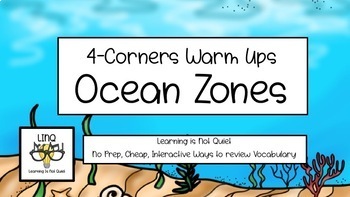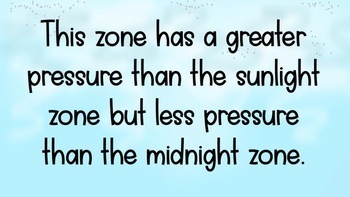4-Corners Ocean Zones Sunlight/Twilight/Midnight/Trenches, No Prep!
- Google Slides™

Description
**PRE-MADE SIGNS IN PREVIEW**
*Note: I do not include the abyssal zone because it isn't included in the VA SOLs.*
This is a strategy that I learned about in a PD meeting. I used it in my classroom and realized a few things immediately:
--> It takes a lot of time to make (which is why I've now made it for you :-)
--> It's very effective
The traditional 4 corners game goes like this:
1) Put up 4 signs around the classroom that say each of the ocean zones (as a vocabulary practice).
2) Project the picture
3) Either call on the entire class to run to the right corner or (as I do it) call on a specific table group or characteristic (all of the people with shoelaces) to run to the correct sign. You can either just do it as a practice or you can give points. This gets kids out of their seats, interacting with the material and vocabulary without any real prep from you.
4) Project the answer. Go over ones that students miss a lot.
I realized as I used this strategy over the years that you can use it in more than one way. I started realizing why it was so effective as I studied linguistics as well. We need to be exposed to a word at least 18 times to incorporate it into our true lexicon. I also realized how we train AI is very similar to this game and strategy. We train computers and robots to understand a concept and then apply that concept by exposing it to thousands of different situations. This goes well with all of the other products related to this topic in my store. I try to keep consistent clipart and language so students build up an understanding of what that word means and then this is a way to get students to see that word in many different ways. No longer do I worry, "oh shoot, hopefully, they don't ask that question THAT way."
Here are 25 ways you can use this product:
WHOLE CLASS:
1. 4 Corners Game: (as described above)
2. 4 Corners Characteristic Game (calling individual groups or characteristics)
3. Call and Response (show the picture and have the whole class shout it out)
4. Hit the deck (assign a movement with each vocabulary word, have students perform it as Simon says (have students "get out" if they are the last person to make the motion. When you yell "hit the deck" everyone has to lay on the ground, the last person to make it on the ground is out).
5. Play "Silent Ball" (show the first picture and throw a beach or other ball to a student, they need to say what type it is. Show the answer, if they are right, they can stay, if they are wrong they have to sit down).
6. Welcome to Learn: Stand at the door with your computer projecting this PowerPoint have students come in, if they get it right then they come in, if they get it wrong, they have to go to the back of the line.
7. Fly Swatter: Write the vocab words on the board. Divide the class into two teams. Have them form two lines. The front person in each line has a flyswatter (you can buy them at Walmart or the Dollar Store). The person to "swat" the correct term first gets a point and goes to the back of the line. The person who gets it wrong does not get a point and goes to the back of the line.
8. White Board Dash: Show the picture, and have students write what type they see on their whiteboard. Give points to teams that have every person with the correct answer.
STATIONS:
9. Slap It: Put two fly swatters or a push light at a station with a computer and PowerPoint. When students see the picture they slap it when they have the answer, whoever's hand is on the bottom and says the correct answer gets a point (wrong answers = negative point)
10. War: If the two cards are the same type, then the first person to realize this keeps it, if they are not the same, then play another card. If someone makes a mistake and accidentally takes them when they are not the same, they must give 5 cards to their neighbor.
11. Exercise Station: Have a computer at a station. Have students answer together on the count of three. If they both get it right, they can move on to the next photo, if they get it wrong they must do 5 pushups before moving on.
12. Race: Show the photo on a projector or on a computer. Have students write on their whiteboards what they think it is. They can take a step forward if they get it right, take a step back if they get it wrong. The first person who gets across the finish line wins.
STUDYING:
13. Post It: Put this on Google Classroom or send it to parents and students. Have them flip through cards saying what type it is as a study technique.
14. Quiz: Have students quiz each other. One person has a computer and describes the image the other person has to guess what it is.
15. Interactive Notebook: Print out pictures ONLY, a small copy for each student (with specific select slides) (I recommend at least 6 per page). Have them sort and paste the photos with the correct category and title them in your notebooks.
DISPLAY:
16. Word Wall: Use the photos and titles in a picture-based word-wall
ASSESSMENT:
17. Exit Tickets: Cut looseleaf paper into 4 pieces. Pass them out (or have students keep a stash in their science folder for exit tickets). Have students number 1-5. Show the first 5 on day 1 and have them identify, the next 5 on day 2 and so on, in this way you can monitor student progress.
18. PRE / POST Assessment: Have students number 1-20. Show them a random 20 pictures for a pre-assessment and a random 20 pictures for a post-assessment. Even though it's not the same assessment, it is an equal amount of challenge so you can see student progress.
19. Differentiation / ESOL: These products distill very complex concepts into the most basic ideas that students need to know. Even if you already have an assessment for this topic (Like many of the wonderful ones available on my store), you can use this as a differentiated assessment (verbally one-on-one with a select number of students).
EXTENSIONS:
20. CONNECTIONS: Once you have mastered the basic concepts of this, you can have students identify and also add one other vocabulary word from the unit that they see in the photo in a sentence.





